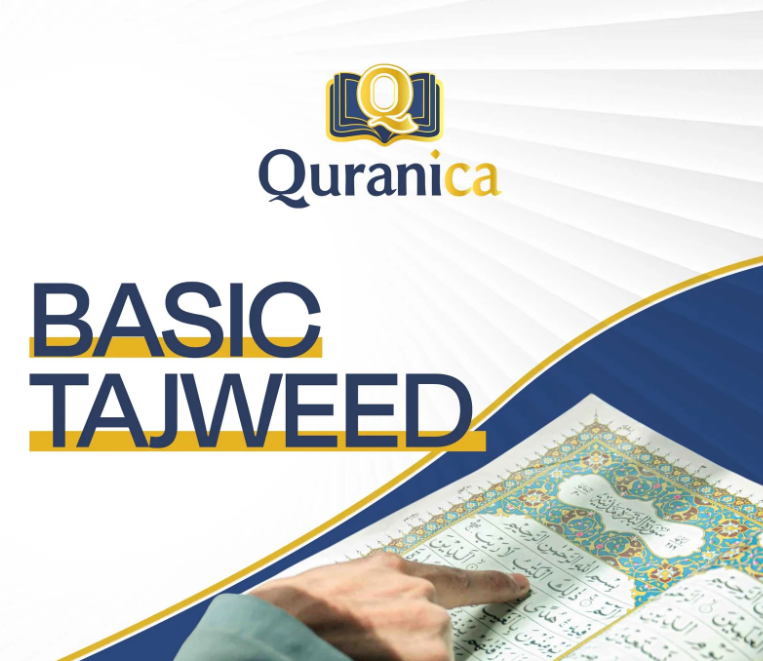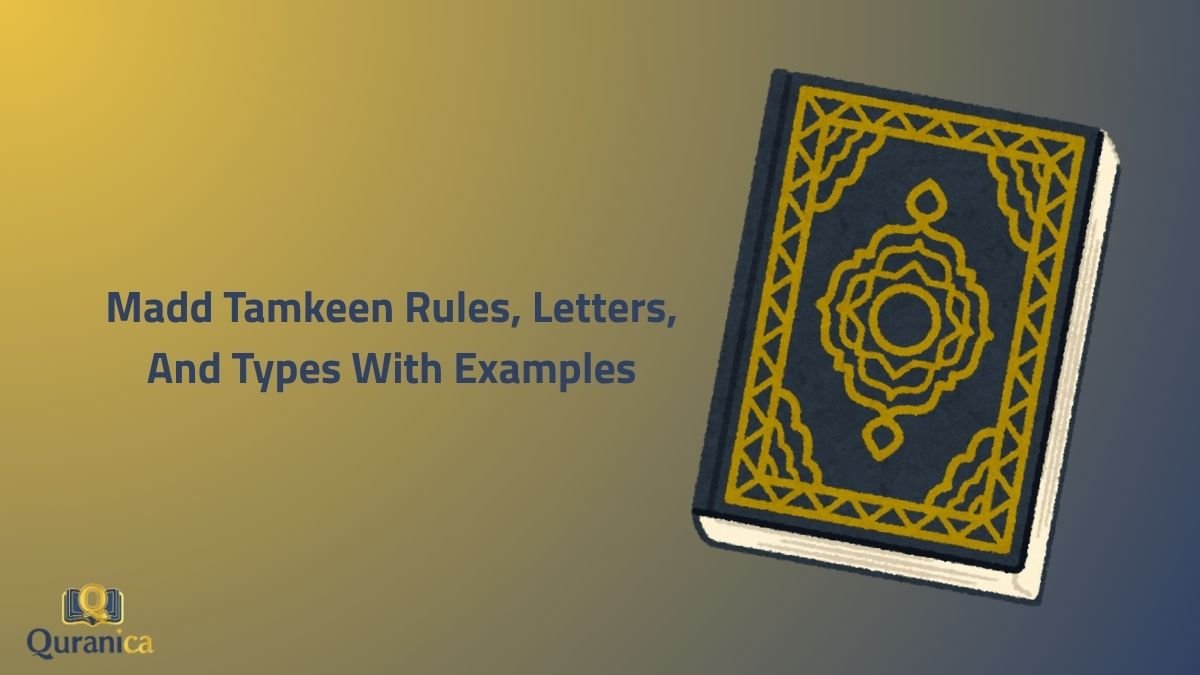Madd Tamkeen is a Tajweed rule that ensures the clear articulation of two identical letters, like Yaˉ’ or Waˉw, when they occur back-to-back in Quranic recitation. By elongating the first letter for two counts, it prevents blending and preserves the meaning and beauty of the text. This rule appears in three main scenarios, each demonstrated through real Quranic examples.
Every letter, every vowel, and every pause has been preserved and passed down through generations. Even the subtle rules, like Madd Tamkeen, are vital in reciting the words of Allah as they were revealed.
This guide is here to walk you through this rule, demystifying it with clear explanations and beautiful examples from the Quran itself.
What is Madd Tamkeen?
Madd Tamkeen is a rule that ensures two similar letters, appearing one after the other, are both heard distinctly. Madd Tamkeen gives the first letter the strength it needs to stand on its own without blending into the second.
1. Madd Tamkeen Meaning
The literal Arabic word “Tamkeen” (تَمْكِين) means empowerment, establishment, or strengthening. This name describes its function.
The Madd “empowers” the sound of the first letter, giving it strength and clarity so that it is not overlooked or merged with the identical letter that follows.
2. Definition of Madd Tamkeen
In the science of Tajweed, Madd Tamkeen is defined as an elongation applied to a Yaˉ’ (ي) or a Waˉw (و) letter.
This elongation serves to properly establish the letter’s sound, especially when it is followed by an identical letter.
3. What is the Madd Tamkeen in the Quran?
Within the context of Quranic recitation, Madd Tamkeen is a practical rule applied to prevent two consecutive identical letters from sounding like one.
Madd Tamkeen in the Quran ensures that when two Yaˉ’s or two Waˉws meet, each one is given its full, proper articulation as intended in the revelation.
Read more about: Tajweed madd Rules: types of Madd, Letters, with chart
Why is Madd Tamkeen important?
The primary purpose of this rule is to maintain absolute clarity in recitation. Without it, for example, two consecutive Yaˉ’s could easily merge together (Idgham), which would obscure the intended sound and, in some cases, alter the meaning of the sacred text.
This rule protects the integrity of the words of Allah. Understanding the ‘why’ behind each rule is a cornerstone of proper learning, a principle we emphasize in Quranica’s Learn Tajweed for beginners Course to build a strong foundation. It is the key to reciting with confidence and precision.

Madd Tamkeen Rules
Let’s explore the specific conditions and characteristics that define this important Madd. The details are what transform a good recitation into a beautiful and correct one.
1. Conditions for Madd Tamkeen
Madd Tamkeen occurs in a few specific scenarios, but the principle is always about separating two identical letters. The two main cases involve either a stressed letter followed by a Madd letter, or a Madd letter followed by a voweled letter.
2. Madd Tamkeen Letter
This rule is exclusive to two letters of the Arabic alphabet. Madd Tamkeen applies only to the letter Yaˉ’ (ي) and the letter Waˉw (و) when they appear under the specific conditions that call for empowerment.
3. How long is Madd Tamkeen?
The length of Madd Tamkeen is consistent and easy to remember. It is elongated for two counts, or two harakāt (حَرَكَات). This is the same length as the most fundamental Madd, the Natural Madd (Madd Tabī’ī).
Types of Madd Tamkeen with Quranic Examples
Madd Tamkeen appears in the Holy Quran in three primary forms. Understanding these scenarios will help you master its application in your recitation.
1. A Stressed Yā’ Followed by a Yā’ of Madd
This type occurs when you find a Yaˉ’ with a Shaddah and a Kasra (ـيِّ), immediately followed by a Yaˉ’ Sākinah (ـيْ) which serves as a letter of Madd. The Madd empowers the sound of the stressed Yaˉ’.
It is important to note that this specific structure occurs with the letter Yaˉ’ but has not been found with the letter Waˉw in the Quran.
“إِنَّ الَّذِينَ يَكْفُرُونَ بِآيَاتِ اللَّهِ وَيَقْتُلُونَ النَّبِيِّينَ بِغَيْرِ حَقٍّ”
“innalladhīna yakfurūna bi’āyāti-llāhi wa yaqtulūna-n-nabiyyīna bighayri ḥaqqin”
“Indeed, those who disbelieve in the verses of Allah and kill the prophets without right” (Surah Aal-Imran: 21).
The rule is on the word النَّبِيِّينَ, where the stressed Yaˉ’ (يِّ) is followed by a Yaˉ’ of Madd, requiring empowerment.
2. A Madd Letter Followed by a Voweled Letter
This form appears when a letter of Madd (Waˉw Madd or Yaˉ’ Madd) is followed by a moving, or voweled, version of the same letter.
The natural Madd of the first letter is firmly established to prevent it from blending into the second.
“الَّذِينَ آمَنُوا وَهَاجَرُوا”
“alladhīna āmanū wa hājarū”
“The ones who have believed, emigrated” (Surah At-Tawbah: 20).
Here, the Waˉw of Madd in آمَنُوا is followed by a voweled Waˉw in وَهَاجَرُوا, requiring the first to be clearly pronounced.
“لَّقَدْ كَانَ فِي يُوسُفَ وَإِخْوَتِهِ آيَاتٌ لِّلسَّائِلِينَ”
“laqad kāna fī yūsufa wa ikhwatihi āyātun li-s-sā’ilīn”
“Certainly were there in Joseph and his brothers signs for those who ask” (Surah Yusuf: 7).
The Yaˉ’ of Madd in فِي is established before the voweled Yaˉ’ at the beginning of يُوسُفَ.
3. A Madd Letter Preceded by a Voweled Letter
The final type occurs when a Yaˉ’ of Madd (ـِيْ) is preceded by a Yaˉ’ with a Kasra (ـيِ), or when a Waˉw of Madd (ـُوْ) is preceded by a Waˉw with a Dammah (ـوُ). This structure also ensures both letters are distinctly articulated.
“اللَّهُ الَّذِي خَلَقَكُمْ ثُمَّ رَزَقَكُمْ ثُمَّ يُمِيتُكُمْ ثُمَّ يُحْيِيكُمْ”
“allāhu-lladhī khalaqakum thumma razaqakum thumma yumītukum thumma yuḥyīkum”
“Allah is the one who created you, then provided for you, then will cause you to die, and then will give you life” (Surah Ar-Rum: 40).
In يُحْيِيكُمْ, the voweled Yaˉ’ (يِ) is followed by a Yaˉ’ of Madd, and the Madd serves to separate the two identical sounds clearly.
More Examples of Madd Tamkeen
Here are more examples to help you identify and practice Madd Tamkeen.
“وَإِذَا حُيِّيتُم بِتَحِيَّةٍ”
“Wa idhā ḥuyyītum bitaḥiyyatin”
“And when you are greeted with a greeting” (Surah An-Nisa: 86).
Here, the Madd Tamkeen occurs on the first ‘Yaa’ (يِّ) which is stressed and followed by a ‘Yaa’ Madd (ي) to empower its sound.
“فِي عِلِّيِّينَ”
“fī ‘illiyyīna”
“Is in ‘Illiyyun” (Surah Al-Mutaffifin: 18).
The stressed ‘Yaa’ with a Kasra (يِّ) is followed by a ‘Yaa’ of Madd, requiring empowerment of the first ‘Yaa’.
“الَّذِي يُوَسْوِسُ فِي صُدُورِ النَّاسِ”
“alladhī yuwaswisu fī ṣudūri-n-nās”
“Who whispers in the breasts of mankind” (Surah An-Nas: 5).
The Madd on the first ‘Yaa’ in “alladhī” is established for two counts to separate it from the voweled ‘Yaa’ in “yuwaswisu”.
“آمَنُوا وَعَمِلُوا الصَّالِحَاتِ”
“āmanū wa ‘amiluṣ-ṣāliḥāt”
“believed and did righteous deeds” (Surah Al-Baqarah: 25).
In this common phrase, the ‘Waw’ of “āmanū” is a Madd letter that must be fully pronounced before the voweled ‘Waw’ of “wa ‘amilu”.
“اصْبِرُوا وَصَابِرُوا وَرَابِطُوا”
“iṣbirū wa ṣābirū wa rābiṭū” “O you who have believed, persevere and endure and remain stationed” (Surah Aal-Imran: 200).
The Madd on the ‘Waw’ in “iṣbirū” is empowered to distinguish it clearly from the following ‘Waw’ in “wa ṣābirū”.
You can test your pronunciation and get instant feedback in Quranica’s Tajweed test and practice sessions.

Read more about: Al-Madd Al-Aarid Lissukoon Rules, & Letters, With Examples
How to Learn Madd Tamkeen
Learning Madd Tamkeen, like all of Tajweed, is an active process of training your ears, your tongue, and your connection to the Quran.
Here are the practical steps a seasoned teacher would guide you through to truly master this rule.
1. Train Your Ear by Listening Intently
Before you can produce a sound correctly, you must be able to hear it correctly. Find a recording of a master Qari known for precise Tajweed, such as Sheikh Mahmoud Khalil Al-Husary.
Listen specifically to the examples mentioned earlier in this article.
Play the verse with حُيِّيتُم (ḥuyyıˉtum) or ءَامَنُوا۟ وَعَمِلُوا۟ (aˉmanuˉwaʿamiluˉ) over and over.
Close your eyes and focus only on how the Qari gives the first letter its full two counts before moving to the next, establishing a clear separation.
2. Practice by Imitating the Masters
Once the correct sound is in your ear, it’s time to train your mouth. This step is about imitation.
Play the verse, pause the recording, and immediately try to recite it exactly as you heard it. This is called “shadowing.”
Pay close attention to the timing of the madd. Does your elongation on the first و (Waw) or ي (Yaa) last for two distinct beats?
Record yourself and compare your recitation to the master Qari’s. This will help you hear the difference between what you think you are doing and what you are actually doing.
3. Isolate and Repeat for Muscle Memory
To perfect the movement of your tongue and lips, you must build muscle memory. Don’t just practice the entire verse. Isolate the specific word where Madd Tamkeen occurs.
For example, repeat the word حُيِّيتُم (ḥuyyıˉtum) ten or fifteen times in a row, focusing on establishing that first ي (Yaa) with its shaddah and kasrah before elongating the second ي (Yaa).
This focused repetition makes the correct pronunciation feel natural and effortless over time.
4. Seek Correction from a Qualified Teacher
This is the most crucial step. You can practice for hours, but you may be reinforcing a subtle mistake without realizing it.
A qualified teacher can hear the nuances you might miss—perhaps your timing is slightly off, or the separation between the letters isn’t quite clear enough.
Reciting directly to an instructor provides you with live, immediate feedback. This is where having a guide becomes invaluable.
The Ijazah-certified teachers at Quranica provide this one-on-one correction, ensuring your dedicated practice truly leads to perfection.
Perfect Madd Tamkeen with Quranica
Learning the rules of Tajweed is the first step; reciting with heart and precision is the beautiful journey that follows.
At Quranica, we are dedicated to making that journey a successful and spiritually fulfilling one for you.
Our instructors are native Arab teachers and proud graduates of the prestigious Al-Azhar University.
They hold an Ijazah (a formal authorization to teach the Quran) and possess years of invaluable experience in teaching the Quran, Arabic, and Tajweed to non-Arabic speakers just like you.
We offer the highest quality of instruction with competitive pricing and flexible schedules to fit your life.
We offer a wide range of specialized programs, including hifz programs, courses to learn Quran recitation and learn Quran with tajweed, our prestigious online ijazah course, and the advanced Ten Qirat Course.
Begin your transformative journey with the Quran today. Register for your free trial class now!
Explore our full range of courses.
Our courses include:
- Arabic-related courses: whether you are a beginner or mid-level. You can choose your level and start from it.
- Memorization (Hifz) Programs: Structured memorization plans that guide students through the Quran at their own pace, supported by experienced instructors.
- Tajweed Courses: Well-designed courses help Muslims to reach the right recitation of the Quran correctly.
- Islamic Studies Courses: These courses help you know more about Islam and Tafsir. This is important since you need to understand the Quran and reflect on your daily life.
Our teachers are carefully selected to be able to explain personalized programs that adapt to each student’s level and goals. They know how to teach a child or an adult, a beginner or an advanced learner. We provide the support you need to grow.
Explore our full range of courses and start a free evaluation session.
Conclusion
Madd Tamkeen is a nuanced rule in Tajweed that ensures clarity in Quranic recitation when two identical letters, such as Yaˉ’ (ي) or Waˉw (و), appear consecutively. It prevents merging of sounds by empowering the first letter to be fully pronounced before the second.
This rule functions as an elongation, typically for two harakāt (counts), to separate similar letters in three primary scenarios: a stressed letter followed by a madd letter, a madd letter followed by a voweled one, and a voweled letter preceding a madd letter. Each case ensures distinct pronunciation.
Examples from the Quran, such as النَّبِيِّينَ (al-nabiyyīn) and يُحْيِيكُمْ (yuḥyīkum), illustrate how Madd Tamkeen preserves the intended sound and meaning of verses. These examples highlight the rule’s practical application and its spiritual significance.
To master Madd Tamkeen, learners are encouraged to actively train by listening to expert reciters, imitating them through shadowing, and isolating target words for repetition. This builds muscle memory for proper articulation.








0 Comments